Item 1: Report to Shareholders| High Yield Fund | November 30, 2007 |
The views and opinions in this report were current as of November 30, 2007. They are not guarantees of performance or investment results and should not be taken as investment advice. Investment decisions reflect a variety of factors, and the managers reserve the right to change their views about individual stocks, sectors, and the markets at any time. As a result, the views expressed should not be relied upon as a forecast of the fund’s future investment intent. The report is certified under the Sarbanes-Oxley Act, which requires mutual funds and other public companies to affirm that, to the best of their knowledge, the information in their financial reports is fairly and accurately stated in all material respects.
REPORTS ON THE WEB
Sign up for our E-mail Program, and you can begin to receive updated fund reports and prospectuses online rather than through the mail. Log in to your account at troweprice.com for more information.
Manager’s Letter
Fellow Shareholders
Following a prolonged period of high-yield market outperformance, the environment for junk bonds became much tougher over the past six months. Although the fundamentals underpinning the companies issuing high-yield bonds remained intact and defaults remain at historically low levels, all financial markets were affected by the subprime mortgage crisis. The primary reason that the subprime meltdown hurt the high-yield market was liquidity. The major broker-dealers have dramatically pulled back from day-to-day trading of riskier securities. Although your fund outperformed its benchmarks, we are never pleased to report losses.
PORTFOLIO PERFORMANCE
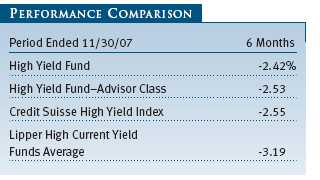
HIGHLIGHTS
• High-yield bonds performed poorly during the past six months.
• The principal cause of losses in the high-yield market was the subprime mortgage crisis and its potential impact on the overall economy.
• The T. Rowe Price High Yield Fund’s returns continued to compare favorably with its peer group.
• We think your portfolio is appropriately positioned to withstand the challenging market environment, and we intend to remain vigilant on risks to both the economy and our individual company exposures.
The High Yield Fund modestly outperformed its benchmarks, the Lipper High Current Yield Funds Average and the Credit Suisse High Yield Index, for the past six months. Advisor Class results were slightly lower, reflecting its different fee structure. The market environment for high-yield bonds remained relatively healthy in the first half of our fiscal year, and defaults remained at a historically low level. However, in a radical reversal, sentiment about the asset class turned sour amid heightened volatility, which led to a flight to quality and stellar performance from Treasury bonds. The principal cause of losses in the high-yield market was liquidity issues stemming from the subprime mortgage crisis and its potential impact on the overall economy.

In this environment, the fund’s share price declined $0.44 for the past six months. During that period, the portfolio generated $0.27 of dividend income, producing a -2.42% total return. The fund’s dividend yield at the end of the reporting period stood at 7.60%, and the SEC standardized yield climbed to 8.00%. (See the glossary for definitions of these terms.) Our long-term returns, which are shown in the table on page 14, show the fund’s strong returns for the five-year bull market and 10-year results that include the bear market for the asset class in 2000-2001.
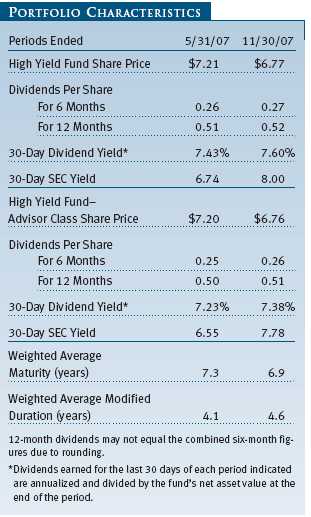
Despite this challenging environment for high-yield bond investing, the T. Rowe Price High Yield Fund continued to compare quite favorably relative to its peer group. Lipper ranked the fund in the top 14% of its high current yield funds universe for the past year and in the top decile of its peer group for the 10-year period ended November 30, 2007. (Based on cumulative total return, Lipper ranked the High Yield Fund 61 out of 447, 109 out of 381, 164 out of 326, and 13 out of 148 funds in the high current yield funds universe for the 1-, 3-, 5-, and 10-year periods ended November 30, 2007, respectively. Results will vary for other time periods. Past performance cannot guarantee future results.)
MARKET ENVIRONMENT
As the fallout of subprime mortgage defaults and delinquencies spread from mortgage companies to big Wall Street firms and major commercial banks, liquidity in the financial markets, particularly in the asset-backed commercial paper market, dried up. The credit market problems prompted investors to sell riskier investments, such as high-yield bonds, and seek out the relative safety of U.S. Treasury securities.
When it became apparent that large numbers of homeowners would have trouble making timely payments on their mortgages, the values of these pools of securities (and associated derivatives) came into question. The inability to value these issues was at the center of the August credit crunch and generated a broad retreat from risk. Risk aversion again resurfaced as an issue in November. Investors were worried about the extent of losses due to subprime mortgage holdings, the capital adequacy of major financial institutions, and heightened price volatility.
Banks imposed tighter lending standards in response to the higher subprime mortgage delinquency rates, which reduced consumer and business borrowing. The fallout spread and liquidity in the financial and credit markets quickly evaporated. The Federal Reserve responded to the liquidity crisis by reducing the discount rate and adding billions of dollars to the banking system on several occasions starting in mid-August. Subsequently, the central bank twice lowered the fed funds target rate from 5.25% to 4.50%, where it remained at the end of the reporting period. These were the first rate cuts in more than four years. (Despite signs of emerging inflationary pressures, the Fed reduced the fed funds rate again to 4.25% on December 11.)
What we witnessed during the past six months was an exogenous shock related to factors outside the high-yield market—the subprime mortgage and structured-product blowups in insurance companies, money market funds, and on Wall Street’s balance sheets had nothing to do with the underlying fundamentals in the high-yield market. Our companies are paying their bills in a timely fashion, and defaults on high-yield credits stand near 1%, a historically low level. What we are seeing is a Wall Street problem. However, our concern is that it may become a Main Street problem. The question that we cannot answer at this juncture is: Will the impact of the subprime crisis continue to curb lending, lead to a tightening of lending standards, and put the brakes on the overall economy? It has already spiked credit spreads (the yield difference between comparable-maturity high-yield bonds and Treasuries) in the high-yield market, making it much more expensive for lower-rated companies to borrow mon ey.
PORTFOLIO REVIEW
Looking back, we were optimistic about the prospects for the high-yield market a year ago, and the asset class continued to generate strong absolute returns through May. However, in the spring we recognized that speculation was running rampant and our asset class was becoming overheated, which prompted us to start ratcheting back risk by selling some of our lower-quality securities and paring equity exposure. We became more conservative but not ultraconservative. We braced the portfolio for what turned out to be the most challenging high-yield market environment in the past five years.

In our shareholder report six months ago, we wrote, “We are cautious on the high-yield market’s short-term performance … investors need to remember that returns of this magnitude are unlikely to be sustained.” We suggested that the catalyst for weaker results would be the new issue calendar and the large leveraged buyout (LBO) transactions that were on the horizon. In hindsight, we were correct in that assessment but the bigger problem was the mortgage crisis—it affected all major financial institutions. Investment banks were hurt the most by the financial engineering trend of the past five years. We have seen considerable shedding of risk in financial sectors that have significant exposure to mortgages. Rapidly increasing defaults have triggered ratings cuts for securitized products containing subprime mortgages. Prices on these instruments have thus fallen dramatically, which has led to selling across most fixed-income assets as hedge funds and other investors covered losses and reduced exposure. Your portfolio does not hold and has not held any structured investment vehicles (SIVs) or any mortgage securities.
At the end of the reporting period, issues in default represented less than 1% of the high-yield market, and we are pleased to report that thanks to the diligence of our top-notch analyst team, your portfolio did not own any issues that defaulted this year. We have not even had any significant credit problems, although we have purchased some distressed credits as special situations. The majority of our holdings have strong fundamental characteristics.
As shown in the chart below, spreads in the high-yield market have widened from a low of 263 basis points in early June to 575 basis points at the end of the reporting period (100 basis points equal 1.00%). The market is now priced to compensate investors for about a 5% default rate.

If, as we suspect, those defaults don’t materialize over the next 12 months and the economy stabilizes and does not dip into a recession, we believe the high-yield market could rally, leading to better performance for the asset class in 2008 than in 2007. At the end of the reporting period, the high-yield market was yielding about 9%. In an environment where the five-year Treasury is yielding about 3.3%, we think that junk bonds are attractively valued.
The spread on high-yield bonds over comparable-maturity Treasuries indicates that the market believes the economy is going to enter a recession. We are not in agreement on that score. However, there is a body of evidence that suggests the mortgage crisis is going to severely hurt the consumer, and that has led us to position the portfolio away from consumer sectors. Clearly, there are problem sectors in the economy today, including financial services, housing, retailing, and consumer products. If consumer spending slows dramatically, we anticipate that these sectors would suffer the most pain. In the high-yield benchmark, those sectors represent about 13% of assets, which is a relatively low weighting. Because of our defensive posturing, those four sectors accounted for only 8% of the portfolio at the end of the reporting period.
If a consumer-led recession plays out, we believe the fund is defensively positioned to withstand it. In the spring, we trimmed our riskier bonds and convertible and common stocks and rotated into bank loans and floating-rate debt. And, when our housing analyst told us not to own any homebuilders’ bonds, we sold them all, which significantly benefited our relative performance. The fund is currently overweight in defensive sectors that should be able to ride out what could be an “economic hurricane.”
Our largest industry exposure, as shown in the table on page 12, is energy. With oil at $90 per barrel, profitability in the group has been exceptionally strong. The industry is generating steady earnings and great cash flow. We also have a 9% allocation in diversified services companies. Although some are cyclical, companies such as Allied Waste, which is a trash collector, are going to fare well no matter what the economy does, because even in a recession, people will need its services. Aramark is another large holding that should be relatively insulated from the effects of a recession. It specializes in stadium vending and institutional food services for universities, colleges, and hospitals. Utilities is our third-largest sector, at about 8% of assets, and has always been considered a defensive sector. Although utilities can be somewhat cyclical due to their industrial customers, the revenue and cash flow base is relatively stable and the bonds we own are high quality. Should yields trend lower, these companies should benefit. (Please refer to the portfolio of investments for a complete listing of holdings and the amount each represents in the portfolio.)
NOTABLE PORTFOLIO ADDITIONS
Selectivity and exhaustive research are the hallmarks of our investment strategy. In our last shareholder letter, we featured the rationale and investment merit of Freeport-McMoRan Copper & Gold, our largest holding and most significant purchase in the prior six-month period. It’s now our second-largest holding and continues to generate stand-out performance.
Our largest purchase since May, and far and away the largest portfolio holding on November 30, was Texas Competition Electric (formerly known as Texas Utilities). This utility was taken private by Kolberg Kravis Roberts & Co. (KKR) in October. The company has major operations in one of the highest energy usage markets in the country and practically holds a leading position in its territories. The offering—a leveraged buyout—was one of the largest in the history of the asset class. Because of the stress in the credit markets, we were able to buy their 10-year bonds at yields in excess of 11%, some of their bank debt with a coupon of 8.25%, and the operating company’s seven-year bonds with a 10.25% coupon. In aggregate, the position represented 3.1% of the portfolio’s total net assets on November 30.
We also established a large new position in First Data, the country’s largest credit card processing company with an almost 50% market share. It is a great business because of its stability and increasingly more transactions are made with credit and debit cards. The company was also taken private in an LBO by KKR in October. We bought seven-year bonds with a 9.875% coupon at a discount and their bank debt yielding 8%. At the end of the reporting period, First Data was the portfolio’s third-largest holding, representing 1.7% of the fund.
In health care, we added Bausch & Lomb, the eye care, contact lens, and solution maker. We purchased seven-year bonds yielding about 10%. While we have been defensive from a top-down portfolio construction standpoint, which should be beneficial if the economy goes into recession, we have been actively looking for new positions in the LBO market. As always, we want to own companies with leading market shares that represent compelling value and can generate strong, consistent cash flow.
Unfortunately, not every LBO purchase has worked out. We liked Outback Steakhouse’s prospects and took a moderately sized position in its new bonds—about $25 million of seven-year bonds yielding 10%. Given the growing concern about consumer spending, the bonds subsequently traded down to about 80 cents on the dollar. In addition to poor sentiment, the company was hurt by higher food and energy costs. We are never happy to incur losses, and we continue to monitor the fundamentals of the company closely.
Although we avoided a significant amount of pain by minimizing our positions in financial services, we were hurt by our holdings in General Motors Acceptance Corporation (GMAC). While the fundamentals of auto financing remain much healthier than the home mortgage market, GMAC has a subsidiary, ResCap, that is involved in mortgage lending. The significant losses at ResCap drove down the price of GMAC bonds in the past three months. Although we pared our position to about 1%, the losses were painful. Ford Motor, on the other hand, performed better. We own a defensive Ford security that has a put feature, which means we can sell the bonds back to the company at their full value. Together, Ford Credit and GMAC represent a significant part of the financial services segment of the high-yield market. Our smaller position in Ford bonds was trading near par at the end of the reporting period.
OUTLOOK
There is still plenty of uncertainty in the high-yield market. The investment community remains riveted on the outlook for the economy, and we believe that junk bonds will take their cues from the overall economic trends related to consumer spending, employment, and interest rates. The December 11 quarter-point rate cut is evidence that the Federal Reserve is trying to prevent the economy from moving into a recession. But the Fed is caught between the proverbial rock, trying to avoid recession, and a hard place, igniting inflation. We expect more fed funds rate cuts over the next six to nine months as the central bank attempts to engineer an economic soft landing. (On December 11, after the end of our reporting period, the Fed cut short-term rates an additional 0.25%.)
Policymakers in Washington and at the Treasury Department are studying potential solutions for the mortgage crisis, specifically related to the subprime mortgage default reset provisions. In our view, the high-yield market is at a tipping point—it could get worse, or significantly better. With the market’s current 600-basis-point spread to Treasuries, we do not see a need for spreads to widen much further. There have been very few instances historically when spreads have widened beyond 700 basis points.
We still don’t know how badly Wall Street has been hurt by its exposure to structured investment vehicles. The overall health of the investment banking world is important to the psychology of the high-yield market because these firms are the intermediaries for our asset class. We are reasonably sure that credit will be in shorter supply for the foreseeable future, that the housing market has further to fall, and that regulators will step in to curb the casino mentality displayed by investment bankers, hedge funds, and private-equity operations.
While we think your portfolio is appropriately positioned to withstand the challenging market environment, we would also caution investors that a recession could have a negative impact on many of our companies. We intend to remain vigilant on risks to both the economy and our individual company exposures.
We appreciate your confidence and thank you for investing with T. Rowe Price.
Respectfully submitted,

Mark J. Vaselkiv
Chairman of the fund’s Investment Advisory Committee
December 20, 2007
The committee chairman has day-to-day responsibility for managing the portfolio and works with committee members in developing and executing the fund’s investment program.
RISKS OF BOND INVESTING
Bonds are subject to interest rate risk, the decline in bond prices that usually accompanies a rise in interest rates, and credit risk, the chance that any fund holding could have its credit rating downgraded or that a bond issuer will default (fail to make timely payments of interest or principal), potentially reducing the fund’s income level and share price. High-yield corporate bonds could have greater price declines than funds that invest primarily in high-quality bonds. Companies issuing high-yield bonds are not as strong financially as those with higher credit ratings, so the bonds are usually considered speculative investments.
GLOSSARY
30-day dividend yield: Dividends earned for the last 30 days of the period indicated are annualized and divided by the fund’s net asset value at the end of the period.
30-day SEC yield: A method of calculating a fund’s yield that assumes all portfolio securities are held until maturity. The Securities and Exchange Commission (SEC) requires all bond funds to calculate this yield. Yield will vary and is not guaranteed.
Credit Suisse High Yield Index: Tracks the performance of domestic noninvestment-grade corporate bonds.
Duration: A measure of a bond or bond fund’s sensitivity to changes in interest rates. For example, a fund with a four-year duration would fall about 4% in response to a one-percentage-point rise in interest rates, and vice versa.
Federal funds rate: The interest rate charged on overnight loans of reserves by one financial institution to another in the United States. The Federal Reserve sets a target federal funds rate to affect the direction of interest rates.
Lehman Brothers U.S. Aggregate Index: An unmanaged index that tracks domestic investment-grade bonds, including corporate, government, and mortgage-backed securities.
Lipper averages: Consist of all mutual funds in a particular category as tracked by Lipper Inc.
London Interbank Offered Rate (Libor): The interest rate at which banks loan money to each other in the London wholesale market, which is also known as the interbank market.
Weighted average maturity: The weighted average of the stated maturity dates of the portfolio’s securities. In general, the longer the average maturity, the greater the fund’s sensitivity to interest rate changes. A shorter average maturity usually means less interest rate sensitivity and therefore a less volatile portfolio.


Performance and Expenses
This chart shows the value of a hypothetical $10,000 investment in the fund over the past 10 fiscal year periods or since inception (for funds lacking 10-year records). The result is compared with benchmarks, which may include a broad-based market index and a peer group average or index. Market indexes do not include expenses, which are deducted from fund returns as well as mutual fund averages and indexes.

| AVERAGE ANNUAL COMPOUND TOTAL RETURN |
This table shows how the fund would have performed each year if its actual (or cumulative) returns for the periods shown had been earned at a constant rate.
As a mutual fund shareholder, you may incur two types of costs: (1) transaction costs, such as redemption fees or sales loads, and (2) ongoing costs, including management fees, distribution and service (12b-1) fees, and other fund expenses. The following example is intended to help you understand your ongoing costs (in dollars) of investing in the fund and to compare these costs with the ongoing costs of investing in other mutual funds. The example is based on an investment of $1,000 invested at the beginning of the most recent six-month period and held for the entire period.
Please note that the fund has two share classes: The original share class (“investor class”) charges no distribution and service (12b-1) fee. Advisor Class shares are offered only through unaffiliated brokers and other financial intermediaries and charge a 0.25% 12b-1 fee. Each share class is presented separately in the table.
Actual Expenses
The first line of the following table (“Actual”) provides information about actual account values and expenses based on the fund’s actual returns. You may use the information in this line, together with your account balance, to estimate the expenses that you paid over the period. Simply divide your account value by $1,000 (for example, an $8,600 account value divided by $1,000 = 8.6), then multiply the result by the number in the first line under the heading “Expenses Paid During Period” to estimate the expenses you paid on your account during this period.
Hypothetical Example for Comparison Purposes
The information on the second line of the table (“Hypothetical”) is based on hypothetical account values and expenses derived from the fund’s actual expense ratio and an assumed 5% per year rate of return before expenses (not the fund’s actual return). You may compare the ongoing costs of investing in the fund with other funds by contrasting this 5% hypothetical example and the 5% hypothetical examples that appear in the shareholder reports of the other funds. The hypothetical account values and expenses may not be used to estimate the actual ending account balance or expenses you paid for the period.
Note: T. Rowe Price charges an annual small-account maintenance fee of $10, generally for accounts with less than $2,000 ($500 for UGMA/UTMA). The fee is waived for any investor whose T. Rowe Price mutual fund accounts total $25,000 or more, accounts employing automatic investing, and IRAs and other retirement plan accounts that utilize a prototype plan sponsored by T. Rowe Price (although a separate custodial or administrative fee may apply to such accounts). This fee is not included in the accompanying table. If you are subject to the fee, keep it in mind when you are estimating the ongoing expenses of investing in the fund and when comparing the expenses of this fund with other funds.
You should also be aware that the expenses shown in the table highlight only your ongoing costs and do not reflect any transaction costs, such as redemption fees or sales loads. Therefore, the second line of the table is useful in comparing ongoing costs only and will not help you determine the relative total costs of owning different funds. To the extent a fund charges transaction costs, however, the total cost of owning that fund is higher.

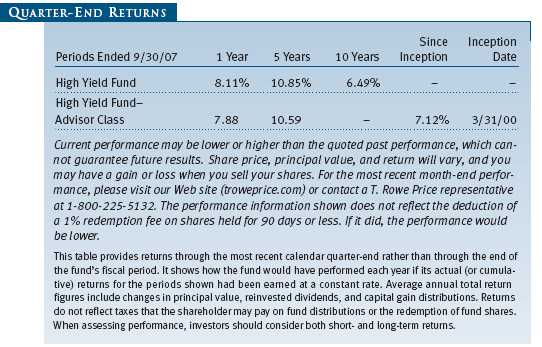

Unaudited

The accompanying notes are an integral part of these financial statements.
Unaudited

The accompanying notes are an integral part of these financial statements.
Unaudited
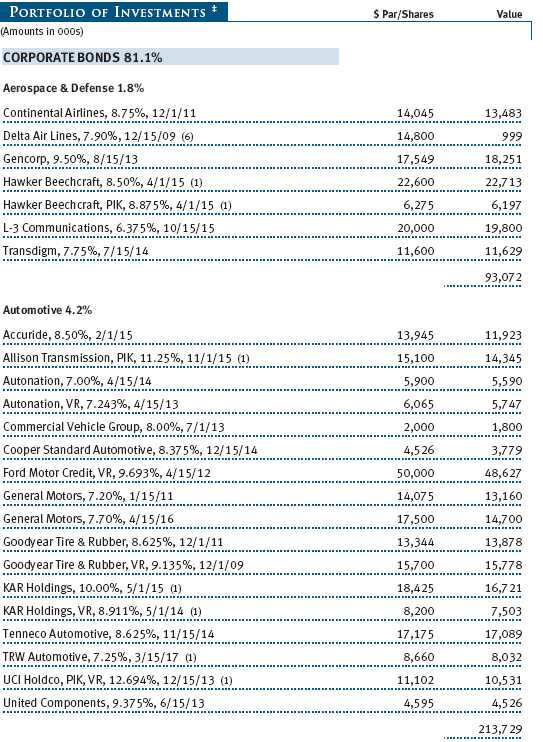

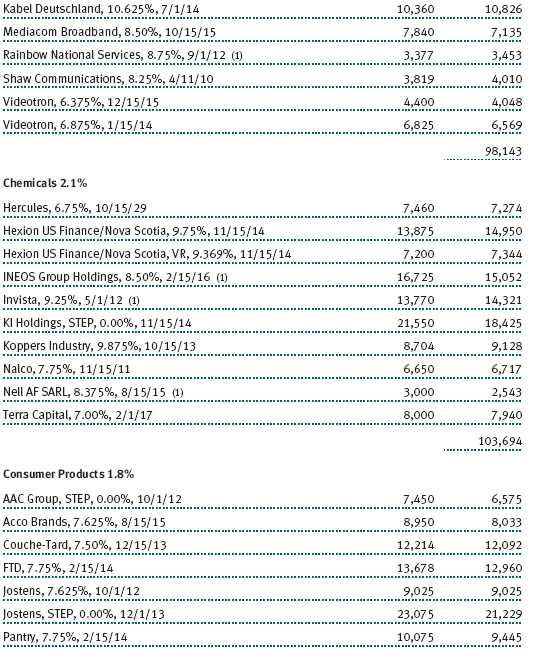


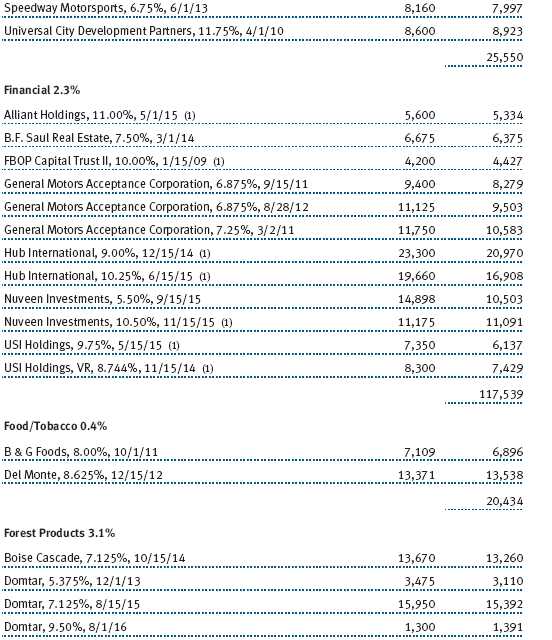






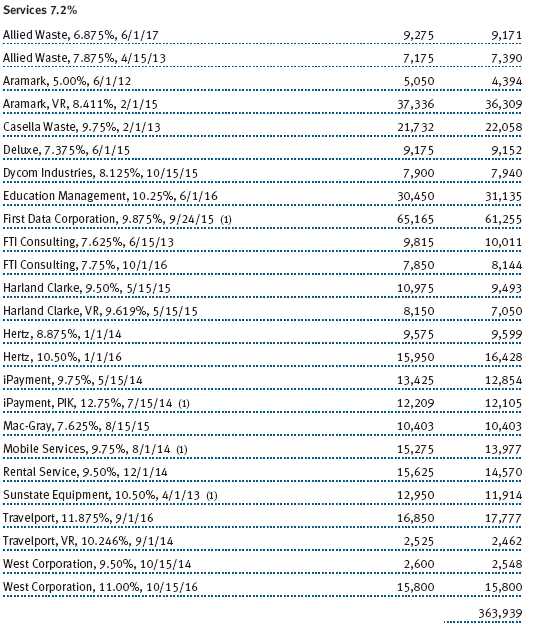




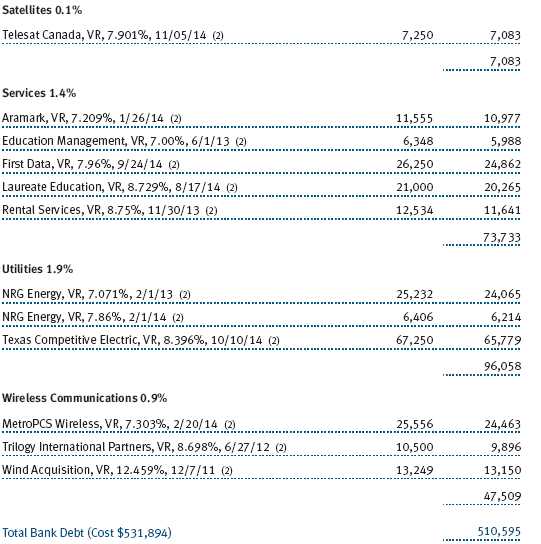
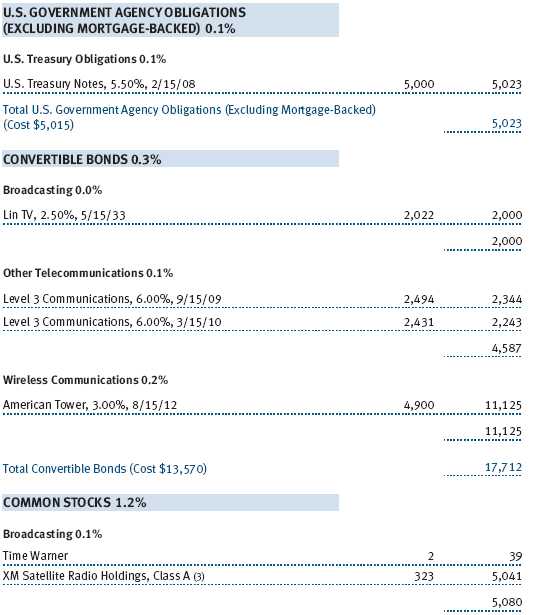





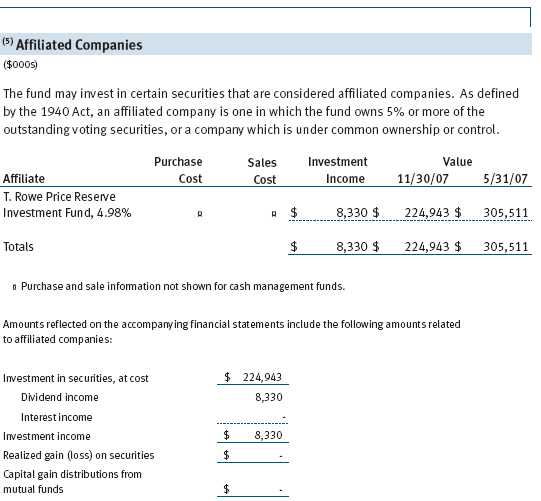


The accompanying notes are an integral part of these financial statements.
Unaudited

The accompanying notes are an integral part of these financial statements.
Unaudited


The accompanying notes are an integral part of these financial statements.
Unaudited
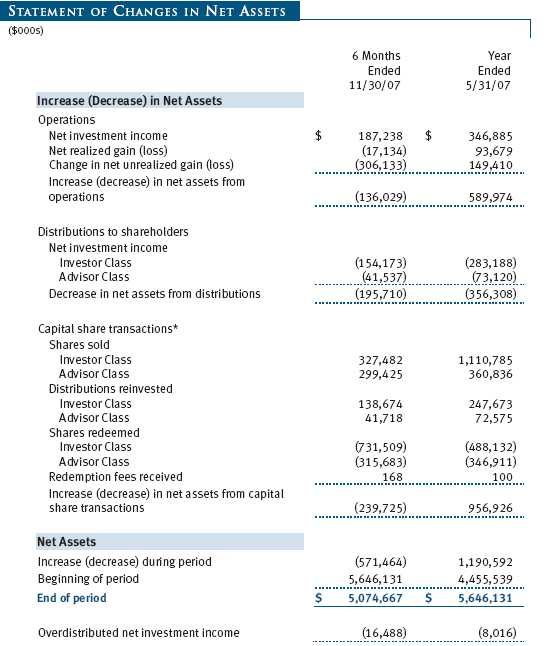

The accompanying notes are an integral part of these financial statements.
Unaudited
| NOTES TO FINANCIAL STATEMENTS |
NOTE 1 - SIGNIFICANT ACCOUNTING POLICIES
T. Rowe Price High Yield Fund, Inc. (the fund), is registered under the Investment Company Act of 1940 (the 1940 Act) as a diversified, open-end management investment company. The fund seeks high current income and, secondarily, capital appreciation. The fund has two classes of shares: the High Yield Fund original share class, referred to in this report as the Investor Class, offered since December 31, 1984, and High Yield Fund—Advisor Class (Advisor Class), offered since March 31, 2000. Advisor Class shares are sold only through unaffiliated brokers and other unaffiliated financial intermediaries that are compensated by the class for distribution, shareholder servicing, and/or certain administrative services under a Board-approved Rule 12b-1 plan. Each class has exclusive voting rights on matters related solely to that class, separate voting rights on matters that relate to both classes, and, in all other respects, the same rights and obligations as the other class.
The accompanying financial statements were prepared in accordance with accounting principles generally accepted in the United States of America, which require the use of estimates made by fund management. Fund management believes that estimates and security valuations are appropriate; however, actual results may differ from those estimates, and the security valuations reflected in the financial statements may differ from the value the fund ultimately realizes upon sale of the securities.
Valuation The fund values its investments and computes its net asset value per share at the close of the New York Stock Exchange (NYSE), normally 4 p.m. ET, each day that the NYSE is open for business. Debt securities are generally traded in the over-the-counter market. Securities with original maturities of one year or more are valued at prices furnished by dealers who make markets in such securities or by an independent pricing service, which considers yield or price of bonds of comparable quality, coupon, maturity, and type, as well as prices quoted by dealers who make markets in such securities. Securities with original maturities of less than one year are valued at amortized cost in local currency, which approximates fair value when combined with accrued interest.
Equity securities listed or regularly traded on a securities exchange or in the over-the-counter (OTC) market are valued at the last quoted sale price or, for certain markets, the official closing price at the time the valuations are made, except for OTC Bulletin Board securities, which are valued at the mean of the latest bid and asked prices. A security that is listed or traded on more than one exchange is valued at the quotation on the exchange determined to be the primary market for such security. Listed securities not traded on a particular day are valued at the mean of the latest bid and asked prices for domestic securities and the last quoted sale price for international securities.
Investments in mutual funds are valued at the mutual fund’s closing net asset value per share on the day of valuation. Swap agreements are valued at prices furnished by dealers who make markets in such securities or by an independent pricing service.
Other investments, including restricted securities, and those for which the above valuation procedures are inappropriate or are deemed not to reflect fair value are stated at fair value as determined in good faith by the T. Rowe Price Valuation Committee, established by the fund’s Board of Directors.
Most foreign markets close before the close of trading on the NYSE. If the fund determines that developments between the close of a foreign market and the close of the NYSE will, in its judgment, materially affect the value of some or all of its portfolio securities, which in turn will affect the fund’s share price, the fund will adjust the previous closing prices to reflect the fair value of the securities as of the close of the NYSE, as determined in good faith by the T. Rowe Price Valuation Committee, established by the fund’s Board of Directors. A fund may also fair value securities in other situations, such as when a particular foreign market is closed but the fund is open. In deciding whether to make fair value adjustments, the fund reviews a variety of factors, including developments in foreign markets, the performance of U.S. securities markets, and the performance of instruments trading in U.S. markets that represent foreign securities and baskets of foreign securities. The fund uses outside pricing services to provide it with closing market prices and information used for adjusting those prices. The fund cannot predict when and how often it will use closing prices and when it will adjust those prices to reflect fair value. As a means of evaluating its fair value process, the fund routinely compares closing market prices, the next day’s opening prices in the same markets, and adjusted prices.
Currency Translation Assets, including investments, and liabilities denominated in foreign currencies are translated into U.S. dollar values each day at the prevailing exchange rate, using the mean of the bid and asked prices of such currencies against U.S. dollars as quoted by a major bank. Purchases and sales of securities, income, and expenses are translated into U.S. dollars at the prevailing exchange rate on the date of the transaction. The effect of changes in foreign currency exchange rates on realized and unrealized security gains and losses is reflected as a component of security gains and losses.
Class Accounting The Advisor Class pays distribution, shareholder servicing, and/or certain administrative expenses in the form of Rule 12b-1 fees, in an amount not exceeding 0.25% of the class’s average daily net assets. Shareholder servicing, prospectus, and shareholder report expenses incurred by each class are charged directly to the class to which they relate. Expenses common to both classes and investment income are allocated to the classes based upon the relative daily net assets of each class’s settled shares; realized and unrealized gains and losses are allocated based upon the relative daily net assets of each class’s outstanding shares.
Credits The fund earns credits on temporarily uninvested cash balances at the custodian that reduce the fund’s custody charges. Custody expense in the accompanying financial statements is presented before reduction for credits, which are reflected as expenses paid indirectly.
Redemption Fees A 1% fee is assessed on redemptions of fund shares held for 90 days or less to deter short-term trading and to protect the interests of long-term shareholders. Redemption fees are withheld from proceeds that shareholders receive from the sale or exchange of fund shares. The fees are paid to the fund, and are recorded as an increase to paid-in capital. The fees may cause the redemption price per share to differ from the net asset value per share.
Investment Transactions, Investment Income, and Distributions Income and expenses are recorded on the accrual basis. Premiums and discounts on debt securities are amortized for financial reporting purposes. Dividends received from mutual fund investments are reflected as dividend income; capital gain distributions are reflected as realized gain/loss. Dividend income and capital gain distributions are recorded on the ex-dividend date. Income tax-related interest and penalties, if incurred, would be recorded as income tax expense. Investment transactions are accounted for on the trade date. Realized gains and losses are reported on the identified cost basis. Net periodic receipts or payments required by swaps are accrued daily and recorded as realized gain or loss in the accompanying financial statements. Fluctuations in the fair value of swaps are reflected in the change in net unrealized gain or loss and are reclassified to realized gain or loss upon termination prior to maturity. Distributions to shareholders are recorded on the ex-dividend date. Income distributions are declared by each class on a daily basis and paid monthly. Capital gain distributions, if any, are declared and paid by the fund, typically on an annual basis.
New Accounting Pronouncements Effective November 30, 2007, the fund adopted Financial Accounting Standards Board (FASB) Interpretation No. 48 (FIN 48), Accounting for Uncertainty in Income Taxes, a clarification of FASB Statement No. 109, Accounting for Income Taxes. FIN 48 establishes financial accounting and disclosure requirements for recognition and measurement of tax positions taken or expected to be taken on an income tax return. The adoption of FIN 48 had no impact on the fund’s net assets or results of operations.
In September 2006, the FASB released the Statement of Financial Accounting Standard No. 157 (FAS 157), Fair Value Measurements. FAS 157 clarifies the definition of fair value and establishes the framework for measuring fair value, as well as proper disclosure of this methodology in the financial statements. It will be effective for the fund’s fiscal year beginning June 1, 2008. Management is evaluating the effects of FAS 157; however, it is not expected to have a material impact on the fund’s net assets or results of operations.
NOTE 2 - INVESTMENT TRANSACTIONS
Consistent with its investment objective, the fund engages in the following practices to manage exposure to certain risks or to enhance performance. The investment objective, policies, program, and risk factors of the fund are described more fully in the fund’s prospectus and Statement of Additional Information.
Noninvestment-Grade Debt Securities At November 30, 2007, approximately 90% of the fund’s net assets were invested in noninvestment-grade debt securities, commonly referred to as “high-yield” or “junk” bonds. A real or perceived economic downturn or higher interest rates could adversely affect the liquidity or value, or both, of such securities because such events could lessen the ability of issuers to make principal and interest payments.
Restricted Securities The fund may invest in securities that are subject to legal or contractual restrictions on resale. Prompt sale of such securities at an acceptable price may be difficult due to substantial delays and additional costs related to their restrictions.
Swaps During the six months ended November 30, 2007, the fund was a party to credit default swaps under which it buys or sells credit protection against a defined-issuer credit event. Upon a defined-issuer credit event, the fund is required to either deliver the notional amount of the contract in cash and take delivery of the relevant credit or deliver cash approximately equal to the notional amount of the contract less market value of the relevant credit at the time of the credit event. Risks arise from the possible inability of counterparties to meet the terms of their agreements and from changes in creditworthiness of the relevant underlying issuer.
Other Purchases and sales of portfolio securities, other than short-term securities, aggregated $1,772,661,000 and $1,970,029,000, respectively, for the six months ended November 30, 2007.
NOTE 3 - FEDERAL INCOME TAXES
No provision for federal income taxes is required since the fund intends to continue to qualify as a regulated investment company under Subchapter M of the Internal Revenue Code and distribute to shareholders all of its taxable income and gains. Federal income tax regulations differ from generally accepted accounting principles; therefore, distributions determined in accordance with tax regulations may differ in amount or character from net investment income and realized gains for financial reporting purposes. Financial reporting records are adjusted for permanent book/tax differences to reflect tax character. Financial records are not adjusted for temporary differences. The amount and character of tax-basis distributions and composition of net assets are finalized at fiscal year-end; accordingly, tax-basis balances have not been determined as of November 30, 2007.
The fund intends to retain realized gains to the extent of available capital loss carryforwards. As of May 31, 2007, the fund had $251,357,000 of unused capital loss carryforwards, of which $5,025,000 expire in fiscal 2009, $138,022,000 expire in fiscal 2010, and $108,310,000 expire in fiscal 2011.
At November 30, 2007, the cost of investments for federal income tax purposes was $5,165,050,000. Net unrealized loss aggregated $177,263,000 at period-end, of which $41,449,000 related to appreciated investments and $218,712,000 related to depreciated investments.
NOTE 4 - RELATED PARTY TRANSACTIONS
The fund is managed by T. Rowe Price Associates, Inc. (the manager or Price Associates), a wholly owned subsidiary of T. Rowe Price Group, Inc. The investment management agreement between the fund and the manager provides for an annual investment management fee, which is computed daily and paid monthly. The fee consists of an individual fund fee, equal to 0.30% of the fund’s average daily net assets, and a group fee. The group fee rate is calculated based on the combined net assets of certain mutual funds sponsored by Price Associates (the group) applied to a graduated fee schedule, with rates ranging from 0.48% for the first $1 billion of assets to 0.285% for assets in excess of $220 billion. The fund’s group fee is determined by applying the group fee rate to the fund’s average daily net assets. At November 30, 2007, the effective annual group fee rate was 0.30%.
In addition, the fund has entered into service agreements with Price Associates and two wholly owned subsidiaries of Price Associates (collectively, Price). Price Associates computes the daily share prices and provides certain other administrative services to the fund. T. Rowe Price Services, Inc., provides shareholder and administrative services in its capacity as the fund’s transfer and dividend disbursing agent. T. Rowe Price Retirement Plan Services, Inc., provides subaccounting and recordkeeping services for certain retirement accounts invested in the Investor Class. For the six months ended November 30, 2007, expenses incurred pursuant to these service agreements were $99,000 for Price Associates, $546,000 for T. Rowe Price Services, Inc., and $123,000 for T. Rowe Price Retirement Plan Services, Inc. The total amount payable at period-end pursuant to these service agreements is reflected as Due to Affiliates in the accompanying financial statements.
The fund is also one of several mutual funds sponsored by Price Associates (underlying Price funds) in which the T. Rowe Price Spectrum Funds (Spectrum Funds) and T. Rowe Price Retirement Funds (Retirement Funds) may invest. Neither the Spectrum Funds nor the Retirement Funds invest in the underlying Price funds for the purpose of exercising management or control. Pursuant to separate special servicing agreements, expenses associated with the operation of the Spectrum and Retirement Funds are borne by each underlying Price fund to the extent of estimated savings to it and in proportion to the average daily value of its shares owned by the Spectrum and Retirement Funds, respectively. Expenses allocated under these agreements are reflected as shareholder servicing expenses in the accompanying financial statements. For the six months ended November 30, 2007, the fund was allocated $649,000 of Spectrum Funds’ expenses and $1,199,000 of Retirement Funds’ expenses. Of these amounts, $1,400,000 related to services provided by Price. The amount payable at period-end pursuant to this agreement is reflected as Due to Affiliates in the accompanying financial statements. At November 30, 2007, approximately 22% of the outstanding shares of the Investor Class were held by the Spectrum Funds and 28% were held by the Retirement Funds.
The fund may invest in the T. Rowe Price Reserve Investment Fund and the T. Rowe Price Government Reserve Investment Fund (collectively, the T. Rowe Price Reserve Investment Funds), open-end management investment companies managed by Price Associates and affiliates of the fund. The T. Rowe Price Reserve Investment Funds are offered as cash management options to mutual funds, trusts, available for direct purchase by members of the public. The T. Rowe Price Reserve Investment Funds pay no investment management fees.
| INFORMATION ON PROXY VOTING POLICIES, PROCEDURES, AND RECORDS |
A description of the policies and procedures used by T. Rowe Price funds and portfolios to determine how to vote proxies relating to portfolio securities is available in each fund’s Statement of Additional Information, which you may request by calling 1-800-225-5132 or by accessing the SEC’s Web site, www.sec.gov. The description of our proxy voting policies and procedures is also available on our Web site, www.troweprice.com. To access it, click on the words “Company Info” at the top of our homepage for individual investors. Then, in the window that appears, click on the “Proxy Voting Policy” navigation button in the top left corner.
Each fund’s most recent annual proxy voting record is available on our Web site and through the SEC’s Web site. To access it through our Web site, follow the directions above, then click on the words “Proxy Voting Record” at the bottom of the Proxy Voting Policy page.
| HOW TO OBTAIN QUARTERLY PORTFOLIO HOLDINGS |
The fund files a complete schedule of portfolio holdings with the Securities and Exchange Commission for the first and third quarters of each fiscal year on Form N-Q. The fund’s Form N-Q is available electronically on the SEC’s Web site (www.sec.gov); hard copies may be reviewed and copied at the SEC’s Public Reference Room, 450 Fifth St. N.W., Washington, DC 20549. For more information on the Public Reference Room, call 1-800-SEC-0330.
Item 2. Code of Ethics.
A code of ethics, as defined in Item 2 of Form N-CSR, applicable to its principal executive officer, principal financial officer, principal accounting officer or controller, or persons performing similar functions is filed as an exhibit to the registrant’s annual Form N-CSR. No substantive amendments were approved or waivers were granted to this code of ethics during the registrant’s most recent fiscal half-year.
Item 3. Audit Committee Financial Expert.
Disclosure required in registrant’s annual Form N-CSR.
Item 4. Principal Accountant Fees and Services.
Disclosure required in registrant’s annual Form N-CSR.
Item 5. Audit Committee of Listed Registrants.
Not applicable.
Item 6. Schedule of Investments.
Not applicable. The complete schedule of investments is included in Item 1 of this Form N-CSR.
Item 7. Disclosure of Proxy Voting Policies and Procedures for Closed-End Management Investment Companies.
Not applicable.
Item 8. Portfolio Managers of Closed-End Management Investment Companies.
Not applicable.
Item 9. Purchases of Equity Securities by Closed-End Management Investment Company and Affiliated Purchasers.
Not applicable.
Item 10. Submission of Matters to a Vote of Security Holders.
Not applicable.
Item 11. Controls and Procedures.
(a) The registrant’s principal executive officer and principal financial officer have evaluated the registrant’s disclosure controls and procedures within 90 days of this filing and have concluded that the registrant’s disclosure controls and procedures were effective, as of that date, in ensuring that information required to be disclosed by the registrant in this Form N-CSR was recorded, processed, summarized, and reported timely.
(b) The registrant’s principal executive officer and principal financial officer are aware of no change in the registrant’s internal control over financial reporting that occurred during the registrant’s second fiscal quarter covered by this report that has materially affected, or is reasonably likely to materially affect, the registrant’s internal control over financial reporting.
Item 12. Exhibits.(a)(1) The registrant’s code of ethics pursuant to Item 2 of Form N-CSR is filed with the registrant’s annual Form N-CSR.
(2) Separate certifications by the registrant's principal executive officer and principal financial officer, pursuant to Section 302 of the Sarbanes-Oxley Act of 2002 and required by Rule 30a-2(a) under the Investment Company Act of 1940, are attached.
(3) Written solicitation to repurchase securities issued by closed-end companies: not applicable.
(b) A certification by the registrant's principal executive officer and principal financial officer, pursuant to Section 906 of the Sarbanes-Oxley Act of 2002 and required by Rule 30a-2(b) under the Investment Company Act of 1940, is attached.
| | |
SIGNATURES |
| |
| | Pursuant to the requirements of the Securities Exchange Act of 1934 and the Investment |
| Company Act of 1940, the registrant has duly caused this report to be signed on its behalf by the |
| undersigned, thereunto duly authorized. |
| |
| T. Rowe Price High Yield Fund, Inc. |
| |
| |
| |
| By | /s/ Edward C. Bernard |
| | Edward C. Bernard |
| | Principal Executive Officer |
| |
| Date | January 16, 2008 |
| |
| |
| |
| | Pursuant to the requirements of the Securities Exchange Act of 1934 and the Investment |
| Company Act of 1940, this report has been signed below by the following persons on behalf of |
| the registrant and in the capacities and on the dates indicated. |
| |
| |
| By | /s/ Edward C. Bernard |
| | Edward C. Bernard |
| | Principal Executive Officer |
| |
| Date | January 16, 2008 |
| |
| |
| |
| By | /s/ Joseph A. Carrier |
| | Joseph A. Carrier |
| | Principal Financial Officer |
| |
| Date | January 16, 2008 |















































